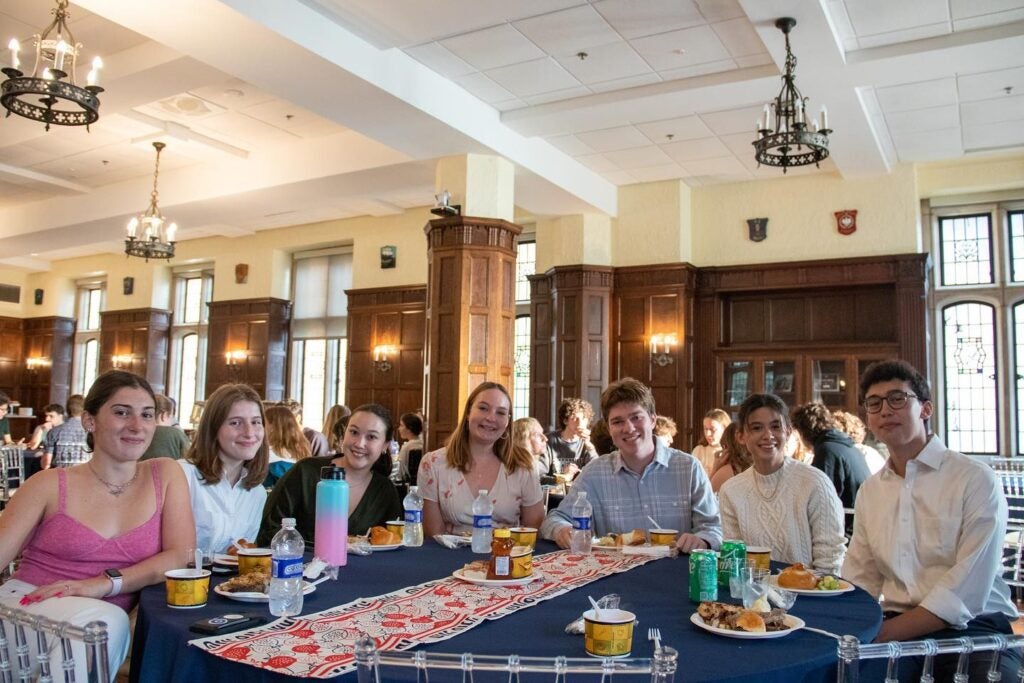High Holy Days Return to Gaston Hall
 Every year, the new school year arrives alongside the Jewish High Holy Days. Rosh Hashanah, the Jewish new year, is followed 10 days later by Yom Kippur, the Day of Atonement and the holiest day of the Jewish year. These holidays transition us from celebration to self-reflection to seeking forgiveness to a sense of renewal.
Every year, the new school year arrives alongside the Jewish High Holy Days. Rosh Hashanah, the Jewish new year, is followed 10 days later by Yom Kippur, the Day of Atonement and the holiest day of the Jewish year. These holidays transition us from celebration to self-reflection to seeking forgiveness to a sense of renewal.
For decades Georgetown University has welcomed the broader community to Gaston Hall to celebrate these holidays. While the pandemic necessitated a break in this tradition, we were so excited to re-open our doors this fall. Hundreds of alumni and community members joined with our students, staff, and faculty to form a sacred community, as we reflected on the last year, acknowledged the ways that we’d missed the mark, and sought to reconnect with God and our best selves.
On Rosh Hashanah, we celebrated with a delicious dinner of brisket, matzah ball soup, and challah (pictured above). We dipped apples in honey to celebrate the sweetness of the new year and listened to the blasts of the shofar, or ram’s horn, designed to wake us from our spiritual slumber. I was so touched by the gratitude of our students for being together again in person and from the members of the community who have made Georgetown their spiritual home for decades.
On Yom Kippur, we separate ourselves from the routine of our daily lives, including eating, drinking, and going to work. I spoke about how separation enables us to realize that we are not our work and that we should not give over the power of our happiness to our jobs, relationships, or anything that is outside our control. Instead, our identity and sense of self-worth should be rooted in our character, the way we treat others, and in being a mensch.
The fall harvest of Sukkot arrives shortly after Yom Kippur to move us into a place of joy and gratitude. Sukkot is a holiday that reminds us to enjoy what we have in the present since so much in life is impermanent. We’ll gather under the sukkah, our temporary hut, on Healey Lawn for a week of eating, relaxing, and harvesting our gratitude.
This fall, I’m so grateful for the support of our interreligious community at Georgetown University. The High Holy Days would not have been possible without the support of staff and students from different faiths. Their help made it possible for the Jewish community to focus on prayer, reflection, and celebration. It’s wonderful to be a part of a community that shows up for each other, in ways big and small.
Everything went very smoothly thanks to the staff at Campus Ministry and our student workers, but we did deal with one major snafu. Our caterers did not deliver the lox for our end of Yom Kippur meal. After fasting for 25 hours, most people are dreaming of their first bite of food. I know our students had their hearts set on breaking their fast with bagels, cream cheese, and lox and the last thing we wanted was to disappoint a hundred hungry students. Thankfully, one of our staff members lept to rescue and drove to Safeway to save the day.
Inhabiting the holiness of Yom Kippur is always easier when we can step outside our daily concerns. Having the support of our interreligious community made it easier for me, for our students, and all our guests to be present and find meaning, belonging, and purpose during these days. It was wonderful to experience my first High Holy Days at Georgetown and experience the magic of celebrating with the support of a multifaith community.
By Rabbi Daniel Schaefer, Interim Director for Jewish Life.